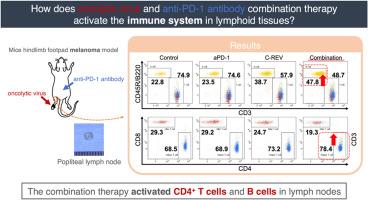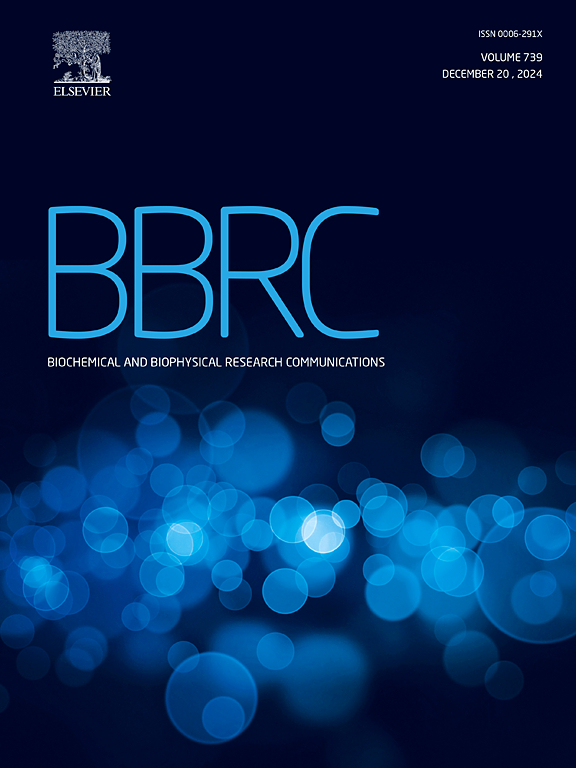Synergistic anti-tumor effects of oncolytic virus and anti-programmed cell death protein 1 antibody combination therapy: For suppression of lymph node and distant metastasis in a murine melanoma model
IF 2.5
3区 生物学
Q3 BIOCHEMISTRY & MOLECULAR BIOLOGY
Biochemical and biophysical research communications
Pub Date : 2024-11-17
DOI:10.1016/j.bbrc.2024.151011
引用次数: 0
Abstract
It is believed that oncolytic viruses (OVs) exert both direct anti-tumor effects by intratumoral injection as well as indirect anti-tumor effects by activating systemic immunity. In phase III clinical trials, OV and anti-programmed cell death-1 (aPD-1) antibody combination therapy showed no significant differences in overall survival and progression-free survival in patients with unresectable advanced melanoma. In the study, OVs can exert only indirect anti-tumor effects in non-injected, systemic lesions. If the tumor is at a stage where both direct and indirect anti-tumor effects of OVs can be expected, OVs may further enhance the therapeutic effect, in addition to the clinically expected therapeutic effect. Therefore, we investigated whether canerpaturev (C-REV) and aPD-1 antibody combination therapy suppresses tumor progression in a murine melanoma model. Our findings showed that the C-REV and aPD-1 antibody combination therapy suppressed tumor progression in a murine melanoma model. The combination therapy stimulated systemic immunity in lymphoid tissues by activating helper T cells and B cells to enhance adaptive and humoral immunity, as well as by increasing effector/memory T cell fractions. Synergistically enhanced systemic anti-tumor effects suppressed lymph node and lung metastases. These findings suggest that direct anti-tumor effects by infecting and destroying cancer cells from within and indirect anti-tumor effects enhanced by the combination therapy worked simultaneously to suppress tumor progression. Our results may provide evidence to support the usefulness of OV and aPD-1 antibody combination therapy as a neoadjuvant therapy in the surgical treatment of melanoma.

溶瘤病毒与抗程序性细胞死亡蛋白 1 抗体联合疗法的协同抗肿瘤效应:在小鼠黑色素瘤模型中抑制淋巴结和远处转移。
一般认为,溶瘤病毒(OV)既能通过瘤内注射发挥直接抗肿瘤作用,也能通过激活全身免疫系统发挥间接抗肿瘤作用。在III期临床试验中,OV和抗程序性细胞死亡-1(aPD-1)抗体联合疗法对不可切除的晚期黑色素瘤患者的总生存期和无进展生存期没有明显差异。在研究中,OV 只能对未注射的全身性病灶产生间接的抗肿瘤作用。如果肿瘤处于可以预期 OVs 直接和间接抗肿瘤作用的阶段,那么除了临床预期的治疗效果外,OVs 还可能进一步增强治疗效果。因此,我们研究了 Canerpaturev(C-REV)和 aPD-1 抗体联合疗法是否能抑制小鼠黑色素瘤模型的肿瘤进展。我们的研究结果表明,C-REV 和 aPD-1 抗体联合疗法抑制了小鼠黑色素瘤模型的肿瘤进展。联合疗法通过激活辅助性T细胞和B细胞来增强适应性免疫和体液免疫,并通过增加效应/记忆性T细胞分数来刺激淋巴组织的全身免疫。协同增强的全身抗肿瘤效应抑制了淋巴结和肺转移。这些研究结果表明,通过从内部感染和破坏癌细胞而产生的直接抗肿瘤效应和通过联合疗法增强的间接抗肿瘤效应可同时抑制肿瘤的发展。我们的研究结果可为 OV 和 aPD-1 抗体联合疗法作为黑色素瘤手术治疗的新辅助疗法提供证据。
本文章由计算机程序翻译,如有差异,请以英文原文为准。
求助全文
约1分钟内获得全文
求助全文
来源期刊
CiteScore
6.10
自引率
0.00%
发文量
1400
审稿时长
14 days
期刊介绍:
Biochemical and Biophysical Research Communications is the premier international journal devoted to the very rapid dissemination of timely and significant experimental results in diverse fields of biological research. The development of the "Breakthroughs and Views" section brings the minireview format to the journal, and issues often contain collections of special interest manuscripts. BBRC is published weekly (52 issues/year).Research Areas now include: Biochemistry; biophysics; cell biology; developmental biology; immunology
; molecular biology; neurobiology; plant biology and proteomics

 求助内容:
求助内容: 应助结果提醒方式:
应助结果提醒方式:


